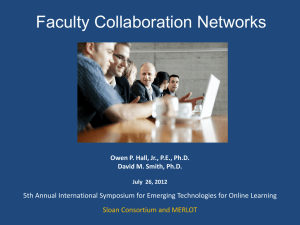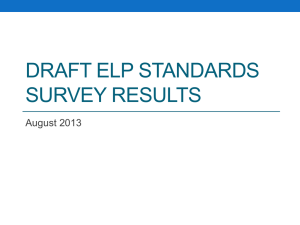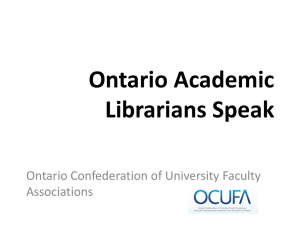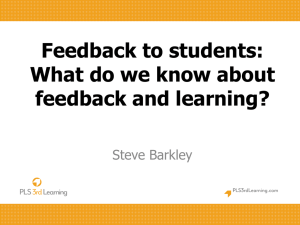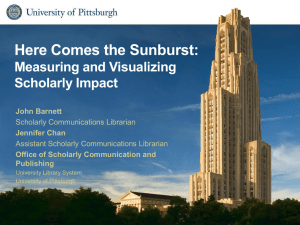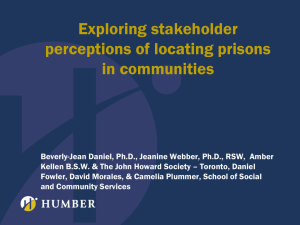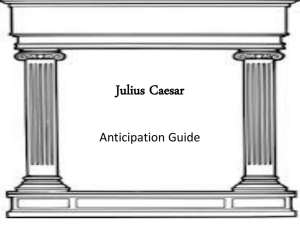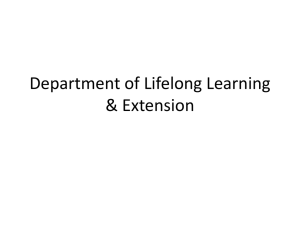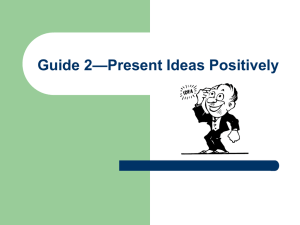JMO Census
advertisement
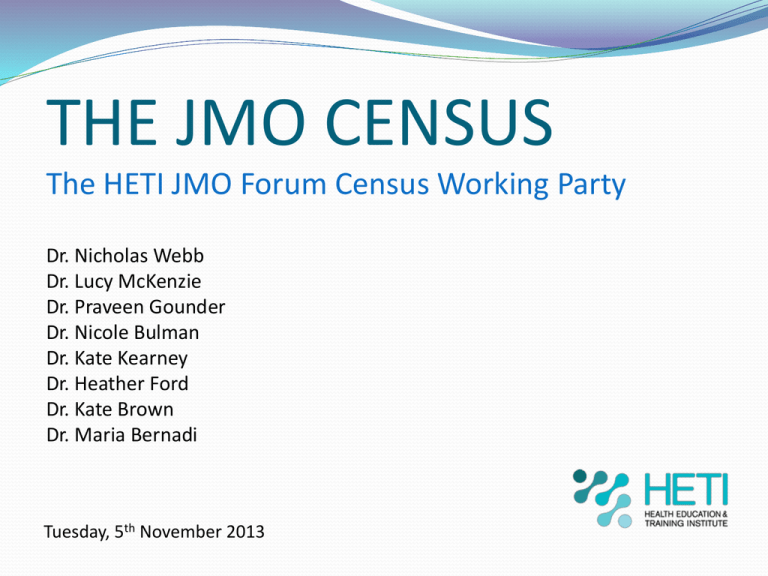
THE JMO CENSUS The HETI JMO Forum Census Working Party Dr. Nicholas Webb Dr. Lucy McKenzie Dr. Praveen Gounder Dr. Nicole Bulman Dr. Kate Kearney Dr. Heather Ford Dr. Kate Brown Dr. Maria Bernadi Tuesday, 5th November 2013 The 2013 JMO Census A comprehensive survey of Junior Medical Officers in NSW and the ACT, investigating the state of JMO welfare, education and training in our public hospitals. Domains of Enquiry 1. Demographics 2. Health and Welfare 3. Supervision 4. Education 5. Career Development 6. Hospital Systems The 2012 JMO Census Pilot A comprehensive survey of Junior Medical Officers in NSW and the ACT, investigating the state of JMO welfare, education and training in our public hospitals. Goals 1. Expand the evidence base on the state of JMOs 2. Develop a tool for multifactorial data analysis by interested parties 3. Gain buy in from parties who wish to survey JMOs 4. Encourage collaboration and information sharing between stakeholders 5. Reduce survey fatigue 6. Deliver a statewide census based on pilot survey results and feedback from stakeholders Pilot Study Survey Design and Delivery • 43 questions comprising 124 parts • • • • • • • Including the Kessler-10 measure of psychological distress Predominantly LIKERT scales • Questions related to current term Paper based Pilot delivered in October 2012, Week 8 of Term 4 10 candidates randomly selected in each of the 16 hospital networks in NSW/ACT HETI JMO Forum representatives delivered survey to participants Surveys mailed to HETI, data de-identified 2013 Census 81 questions PHEEM Kessler-10 Via Survey Monkey Demographics 83 Respondents from 19 hospital sites 82% of respondents were PGY1 57% Female 42% Male Median age was 27 spread from 23-44 years of age Demographics The majority of respondents were single, with no children (67%) 18% married 14% partnered/de-facto 12% with children 60% were born in Australia, though none identified as Indigenous Australians Teaching The majority of respondents (51%) had between 2-4 hours of formal teaching per week 0-2hrs 2-4hrs 4-6hrs 6-8hrs 8+ Teaching Most respondents had at least 1 hour per week of pager free teaching 0hrs 1hrs 2hrs 3hrs 4+ Attendance Attendance varied across respondents, with 38% of respondents attending the recommend 75-100% of all teaching 0-25% 25-50% 50-75% 75-100% Satisfaction 58% of respondents were satisfied with the amount of teaching they attended 87% felt supported to attend teaching However, only 7% of respondents indicated they were not supported to attend teaching The majority of respondents were satisfied with teaching overall (64%) Self education: 58% up to 5 hours/week Rostered Hours 61-70 hours/week (10%) 51-60 hours/week (20%) 38-50 hours/week (70%) Unrostered Hours Unrostered Hours Worked Unrostered Hours Claimed 0hrs 0hrs 0-5hrs 0-5hrs 6-10hrs 6-10hrs 11-15hrs 11-15hrs 15+ 15+ Kessler Psychological Distress Scale Very high (30-50) 4% High (22-29) 9% Moderate (16-21) 30% K10 Total Score Levels 10-15 Low 16-21 Moderate 22-29 High 30-50 Very high Low (10-15) 57% ABS K10 score groupings and categorisation Health and Welfare Only 59% of respondents have a GP of their own! None had used the Doctor’s Health Advisory Service Defined Career Goal Clearly Defined Career Goal Career Intention 35 14 30 12 25 10 20 8 15 6 10 4 5 2 0 Strongly agree Agree Not sure Disagree Strongly disagree 0 Surgery Anaesthetics Paediatrics General Practice Future Practice City Practice Disagree 4% Not sure 10% Agree 52% Strongly disagree 2% Strongly agree 32% Future Practice Rural Practice Strongly disagree 4% Disagree 12% Strongly agree 1% Agree 45% Not sure 38% Future Practice Remote Practice Strongly disagree 23% Strongly agree Agree 0% 7% Not sure 35% Disagree 35% Recommendation of Current Hospital 80% of the pilot group felt their current hospital was an enjoyable place to work, and 80% would recommend their current hospital! Disagree 6% Not sure 13% Agree 46% Strongly disagree 1% Strongly agree 34% Given the Choice Again, Would You Not Study Medicine? 35 Most applicants agreed that, given their time again, they would have still studied medicine 30 25 20 15 10 5 0 Strongly agree Agree Not sure Disagree Strongly disagree Training = Doctor 50 28% of respondents were unsure, or disagreed, that their medical student training prepared them for internship 45 40 35 30 25 20 15 10 5 0 Strongly agree Agree Not sure Disagree Key Figures in the Hospital 45 JMO Manager 40 35 DPET 30 25 Hospital Comittees Available for JMO Education and Training 20 15 10 5 0 Strongly agree Agree Not sure Disagree Strongly disagree Concerns in the Hospital Of the pilot group, 73% believed they knew how to raise concerns, however only 60% of respondents agree or strongly agree that they would be comfortable raising concerns Very few respondents (17%) felt they knew how to raise an industrial dispute, and a similar amount (20%) would feel comfortable to do so In addition, 23% of respondents had experienced workplace bullying in the last year Leave and Benefits Leave: 58% of respondents believe they understand their leave entitlements However, 66% of respondents believed they have appropriate access to leave Benefits: 71% access an employer benefit program Representation 50 45 40 AMA 35 30 HSU 25 MIO 20 15 10 5 0 Strongly agree Agree Not sure Disagree Strongly disagree Next Steps Rollout of Census statewide Return datasets to stakeholders Deliver Census annually Aim for national rollout in 2014 Publication of summary document and data online Wefeelfine .org Issues Identified Privacy Safety Responsible use of data Who will benefit? Final thoughts nicholas-webb@hotmail.com Thank you!
